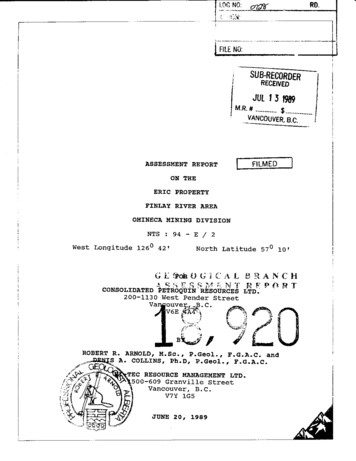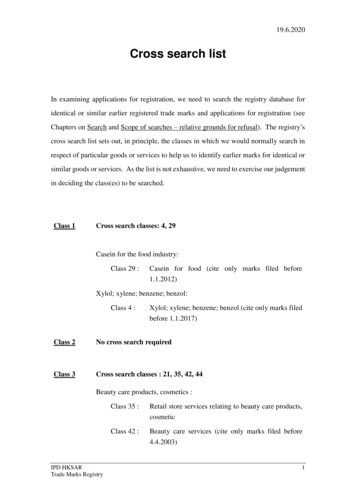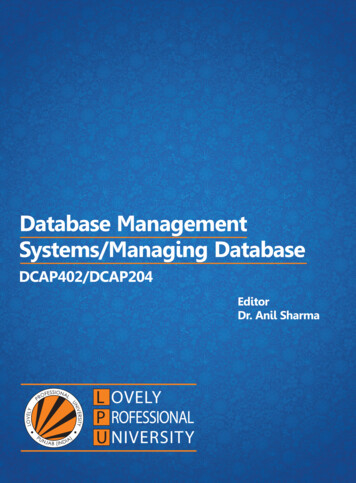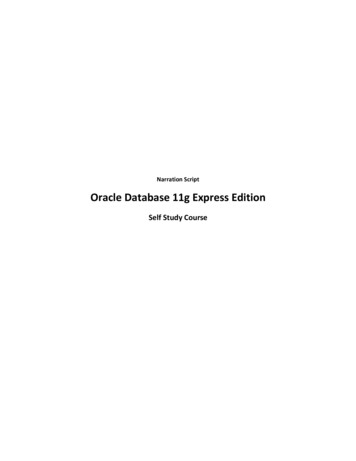
Transcription
RECEIVED1JUI 1 3 1989M.R. # .-.--. -.--.VANCOUVER, 8.C.ASSESSMENT REPORT1-ON THEERIC PROPERTYFINLAY RIVER AREAOMINECA MINING DIVISIONNTS : 94West Longitude 126'42'-E / 2North Latitude 57'10'200-1130 West Pender StreetROBERT R. ARNOLD, M.Sc., P.Geol., F.G.A.C.A. COLLINS, Ph.D, P.Geol., F.G.A.C.EC RESOURCE MANAGEMENT LTD.00-609 Granville StreetVancouver, B. C.V7Y 1G5JUNE 2 0 1 1989and
TABLE OF CONTENTSPaqe1.0SUMMARY.3.0.2.1 Objectives . . . . . . . . . . . . . . . . . .2.2 Location and Access . . . . . . . . . . . . .2.3Physiography . . . . . . . . . . . . . . . . .2.4 Operations and Communications . . . . . . . .2.5 Property Status . . . . . . . . . . . . . . .HISTORY AND PREVIOUS WORK . . . . . . . . . . . . .4.0GEOLOGY2.0INTRODUCTION4.14.25.0.Regional Geology and Mineralization . . . . .Property Geology . . . . . . . . . . . . . . .Magnetometer Survey . . . . . . . . . . . . .VLF-EM Survey . . . . . . . . . . . . . . . .Discussion of Geophysical Results . . . . . NS AND RECOMMENDATIONS7.0REFERENCES.151619
APPENDICESAppendix I:Statements of QualificationsAppendix 11:Instruments SpecificationsAppendix 111: VLF-EM DataAppendix IV:Magnetometer DataAppendix VI:Statement of CostsI1LIST OF ILLUSTRATIONSAfter 6:.Topographic Map . . . . . . . . . . . .ClaimMap. . . . . . . . . . . . . . .Regional Geology Map. . . . . . . . . .Property Geology Map. . . . . . . . . .Grid Location Map . . . . . . . . . . .4General Location Map.4681314 Figure G1A:Figure G1B:Figure G2A:Figure G2B:Figure G2C:Figure G3A:Figure G3B:Figure G4:Magnetics Profile MapTotal Field and Verical Gradient. InMagnetics Contour MapTotal Field.VLF-EM Profiles - SeattleDip Angle and Quadrature.VLF-EM Profiles - SeattleFiltered Dip Angle and Total Field.VLF-EM Contours - SeattleFraser Filter of Dip Angle.VLF-EM Profiles - CutlerDip Angle and Quadrature.VLF-EM Profiles - CutlerFiltered Dip Angle and Total Field.Magnetic and 2 Frequencies VLF-EMCompilation Map.PocketIIIIIIIIIIIIII
1.0SUMMARYPursuant to a request by the Directors of ConsolidatedPetroquin Resources Ltd., VLF-EM and Magnetometersurveys were conducted over selected areas of the EricProperty during April of 1989. The writers performedthe work and researched the literature pertaining tothe area.Previous exploration on the Eric Claim Group consistedof reconnaissance exploration work done by Cominco Ltd.in 1977 and 1981 (geological mapping, rock and soilThis work confirmed thegeochemical sampling)presence of significant gold and silver values inassociation with copper and iron within a porphyrysystem on the Eric Claim.An airborne Magnetic andVLF-EM survey was conducted over the entire propertyduring the spring of 1988 and several very interesting.geophysical features were delineated.The presentexploration program was designed to follow-up anairborne geophysical target found on the Peak Claim.The general area has been explored intermittently forbase metals since the 1930's. Exploration work in theToodoggone Region since the 196Ols has led to thediscovery of three main mineral deposits: the BakerGold Mine (pre-production reserves of 100,000 tons at0.92 oz Au/t), the SEREM's Layers deposit (pre-1985reserves estimated of 1.035 million tons at 0.21 ozAu/t and 7.58 oz Ag/t) and the Energexls A1 property(reserves estimated at 264,000 tons ttopen-pittableat0.248 02 Au/t).Mineralization in the Toodoggone Gold Beltrepresented by four main mineral deposit types:is
a) Porphyry - mainly associated with Ominecaintrusions.b) Skarn - contact of limestone and intrusiverock.c) Stratabound - occurring in or adjacent tolimestone with interbedded chert.d) Epithermal - occurring mostly in Toodoggone andTakla volcanics.Of the four, the epithermal type is the most common.It usually occurs as massive quartz veins (Baker GoldMine) or as silicified zones and amethystine brecciazones (Lawyers Deposit). The epithermal deposit modelis generally associated with siliceous volcaniccenters, exhalative vents and zones of alterationwithin the Toodoggone volcanics and are usually withinclose proximity of major northwest striking faults.Quartz, barite and carbonate are the chief gangueminerals.The vein minerals are acanthite, pyrite,electrum, chalcopyrite, native gold, sphalerite andgalena. Grades range from 0.1 to 1.0 oz Au/t and 1.0to 20.0 oz Ag/t.The limited ground Magnetic and VLF-EM survey conductedin April 1989 on the Peak claim shows a weak magneticlow striking south from line 350N/250W to line 50N/300Wwhich may reflect a fault zone. A weak VLF-EM anomaly(lines 400N and 450N at 250W) is believed to be relatedto a contact on topography.In order to fully evaluate the mineral and economicpotential of the Eric Claim Group further explorationwork is warranted. The two-phase exploration programshould consist of grid establishment, Magnetic and VLFEM surveying, soil and rock geochemical sampling anddetailed geological mapping over the entire property.
I, anexploratory diamond drilling program should be designedto define the geometry and grade characteristics of anyidentified se
42.0.2 1INTRODUCTIONObjectivesPursuant to a request by the Directors of ConsolidatedPetroquin Resources Ltd.,a programof groundgeophysical exploration, consisting of detailed VLF-EMand Magnetometer surveys, was conducted over a selectedportion of the ERIC Property during the early Spring of1989.The purpose of the surveys was to test airborne VLF-EMconductors and Magnetic anomalies delineated during the1988 airborne survey.The present report is based on the results of the 1989geophysical surveys, on the 1988 airborne survey, andon the available literature pertaining to the area.2.2Location and AccessProvince:Area:Mining Division:Mineral Disposition:NTS :Longitude:Latitude :Size of Area:Disposition Holders:British ColumbiaFinlay RiverOminecaEric Claim Group2;''i;IWest57 10' North2200 hectaresConsolidated PetroquinResources Ltd.The Eric property is located in the Toodoggone Riverarea, approximately 280 kilometers north of Smithers,British Columbia (Figures 1 and 2).The Eric ClaimGroup can be accessed by fixed-wing aircraft fromSmithers to the Sturdee airstrip (290 kilometers north
rpPFIr
- 1 -tI SCALE :I Y.T.S.:FIGURE No:
5of Smithers), and fromkilometers to the east.2.3therebyhelicopter20PhysiographyThe Eric Claim Group is located within the divide ofthe Omineca Mountains and the Cassiar Mountains. Thearea exhibits the characteristics of typical glaciatedphysiography.These include wide U-shaped, driftfilled valleys flanked by steep rugged mountains anddeeply incised V-shaped upland valleys.Local topography relief varies from moderate to verysteep. Elevations within the property range from 1,180meters (3,870 feet) in the Finlay River Valley to 1,890meters (6,200 feet) in the Swan 2 claim. Vegetationconsists mainly of mixed grassland and scrub brush withoccasional pine trees in the valleys whereas at higherelevations vegetation grades into alpine growth. Thehighest parts of the property support only moss andlichen.2.4Operations and CommunicationsField work was carried out during the month of April1989. A Bell Ranger helicopter of Canadian Helicoptersbased in Terrace, British Columbia, was used totransport the crew and field equipment from Smithers tothe Skylark Camp on the north side of the Finlay River.The field crew commuted daily from the Skylark Camp tothe property by helicopter.communications were maintainedVancouver, British Columbia.Regular telephonewith the office in
62.5Property S t a t u sThe ERIC Property is recorded in the Smithers MiningRecorder's Office as follows:CLAIMEricPeakSwan 1Swan 2DawnRitaRECORD ORD 19871987198719871989The property consists of 6 contiguous located mineraclaims located in the Omineca Mining Division and allof the claims are 100% owned by Consolidated PetroquinResources Ltd.The claims are shown on the MineralClaims Map 94-E/2E and on Figure 3 of the presentreport.3.0H I S T O R Y AND PREVIOUS WORKA clear and concise history of the exploration in theToodoggone region, and in the area of the subjectproperties, is taken from Yeager and Ikona (AssessmentReport on the Oxide Peak Property, 1986)."The first known mining exploration activity in thearea was placer mining in the Toodoggone River andMcClair Creek in the 1930's. Several lode prospectingventures from that era succeeded in discovering highgrade material at several localities in the Toodoggonedistrict but unfavorable economic conditions precludedthe development of the showings at that time.Theimportance of the discoveries was not recognized andtheir existence was soon forgotten.In the late 1960's, modern exploration programs werecarried out in the region searching for base metalporphyry deposits associated with alkalic intrusive
\\ERIC -.7467(2)12565RITA540665M125566'rI7 -/.PEAKSWAN 1' (8309(4)SWAN 2II831 O(4)./8306(4)'.*\1.'\L-101641II---t01640g2 -'y-\CONSOLIDATED PETRoQurJ RESOURCES LTDERIC CLAIM GROUPOMIMCAMD B C0123 kmCLAIM MAPSCALE:11.7.8.:FlOURE no:
.systems. Following up on silt samples with anomalousbase metal values led to the discovery on gold andsilver mineralization by Kennco on the Chappelleproperty (later Baker Mine) and by Sumito (later SumacMines) on Albert's Hump. The early work done by thesetwo companies drew attention to the area and led to thedevelopment by other companies of what are tional's Baker Mine (Chappelle), SEREM's Lawyersdeposit and Energex's A1 deposits."During the past four years numerous companies exploredover 3,000 mineral claims units in the Toodoggone area.To date, little of the whole belt has been explored on have been indicated on seven differentproperties. Grades and tonnages of the best three are:Baker Mine - 52,000 tonnes at 1.07 oz/t Au and 23.20oz/t Ag; Lawyers - 561,000 tonnes at 0.21 oz/t Au and7.10 oz/t Ag; A1 - 160,000 tonnes at 0.37 oz/t Au.Previous work on the subject property was described byJ.P. Sorbara and H.C. Grond (Report on the EricProperty, dated Feb. 25, 1988) as follows:"Previous work on the Eric claim (then called the Mexclaim) was done by Cominco Ltd. in 1977.The workconsisted of reconnaissance geological mapping, andsoil and rock chip sampling for copper and molybdenummineralization.The geological work indicated anenvironment permissivefor porphyrycopper cant gold values from rock chips taken from analtered zone of quartz-monzonite and monzonite 600 m indiameter.Values ranged from lo to 780 ppb gold inrocks.Follow-up work in 1981 by Cominco outlined an area 600m in diameter which contains gold anomalies in rock andsoil. Gold values range from 10 ppb to 3260 ppb insoils and up to 168 ppb in rocks (Sharp, 1981).Adiamond drilling program was recommended to test thegold/copper zone.
A summary report by Cooke (1986) on the Eric claim gaveresults for 6 rock geochemical samples. The values forgold range from 5 to 145 ppb. Cooke suggests that thealtered zone of intrusive rock and enclosed alteredbreccia may represent a breccia pipe occurring within asub-volcanic intrusive complex. If so the breccia pipemay have served as a conduit for mineralizing fluids.He recommended a program of detailed rock chip samplingand geophysics to test the potential of the property.The four remaining claim blocks (Dawn, Peak, Swan 1 andSwan 2) have no reported work history.I1In early April 1988, an airborne magnetic and VLF-EMsurvey was conducted over the Eric Claim Group byWestern Geophysical Aero Data Ltd. Several interestingmagnetic and VLF-EM features were recognized on theproperty and additional ground follow-up work wasrecommended by geophysicists D.V. Woods, Ph.D., andR.G. Hermary, B.Sc.4.0GEOLOGY4.1Regional Geology and MineralizationThe regional geology of the Toodoggone River has beendescribed in detail by T.G. Shroeter (1981) as follows:u The Toodoggone River area lies within the easternmargin of the Intermontane Belt. The oldest rockexposed are wedges of crystalline limestone more than150 meters thick that have been correlated with theAsitka Group of Permian Age. The next oldest rocksconsist of andesitic flows and pyroclastic rocksincluding augite-tremolite andesite porphyries andcrystal and lapilli tuffs that belong to the TaklaGroup of Late Triassic age. The Omineca intrusions ofJurassic and Cretaceous age (potassium-argon age of 186to 200 Ma obtained by the Geological Survey of Canada)range in composition from granodiorite to quartzmonzonite. Some syenomonzonite bodies and quartzfeldspar porphyry dykes may be feeders to theToodoggone rocks which unconformably overlie the TaklaGroup.TheIToodoggone' volcanicrocks(namedinformally by Carter, 1971) are complexly intercalated
LEGEND1 7 15iB O W S E R GROUP : M i d d l e - L a t e J u rTOODOGGONE VOLCANICS: E a r l y Juras1 7 1 HAZELTON GROUP : E a r l y J u r a s s i cI T ] TAKLA GROUP L a t e T r i a s s i c-1OMINECA INTRUSIONS: L a t e T r i a s s i c - E a r l y1-1A S I T K A GROUP : P e r m i a n:----. -APPROX. G E O L O G I C A L CONTACTFAULTMAJOR D R A I N A G EJurossicREGIONAL GEOLOGY andMINERAL DEPOSITS
9volcanic and volcanic-sedimentary rocks of Early andMiddle Jurassic age, 5 0 0 meters or more in thickness,along the west flank of a northwesterly trending beltof 'basement' rocks at least 90 kilometers in length by15 kilometers in width (Geological Survey of Canada,Open File 306, replaced by Open Files 483 and 606). Apotassium-argon age of 186 /-6 Ma was
Gold Mine (pre-production reserves of 100,000 tons at 0.92 oz Au/t), the SEREM's Layers deposit (pre-1985 reserves estimated of 1.035 million tons at 0.21 oz Au/t and 7.58 oz Ag/t) and the Energexls A1 property (reserves estimated at 264,000 tons ttopen-pittable at 0.248 02 Au/t) . Mineralization in the Toodoggone Gold Belt is










